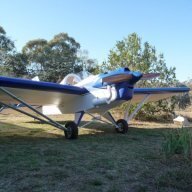OME, that is a fairly typical reaction from those who recoil at the prospect of using house paint on a plane.
But I suggest it is misguided. There is no reason why modern acrylic paint, skilfully sprayed, should not yield a comparable finish to car paint. And house paint has advantages over car paint, not least its flexibility and u.v. protection qualities, quite apart from its lower cost. Modern acrylics are more akin to a flexible plastic coating than old fashioned powdery paint crudely daubed onto a work of art.
For those who are interested in learning with an open mind, the American homebuilder organisation EAA has some excellent online videos on using latex paint for homebuilt aircraft. [Note that what our American cousins call 'latex' paint is actually acrylic - their paint has not contained latex for many years, but it has become the common name for house paint].
The videos will show just how good a finish can be obtained from acrylics, with very high gloss if that's what you want. And many homebuilders will attest to periods in excess of 10 years life for this paint.
I agree it sounds awful to spend thousands of dollars & hours building a plane & then using house paint, because of its associations. But when you consider the harsh conditions experienced by houses - exposed 24/7 to very high solar radiation, temperature extremes, wind & rain - then it is unsurprising that a plane spending most of its life in a hangar will still look very good after many years.
Conversely, some owners have complained of cracking after relatively short periods using automotive paints.
But of course it is possible to point to both good & bad results from both paints. Personally, I am very pleased with my acrylic paint job, despite my lack of skill with a spray gun. And my test piece of wing has withstood more sun & rain already than my plane will in its entire life.
Howsomever, you pays your money and you takes your choice. It just may pay you to make that choice objectively.
Bruce







